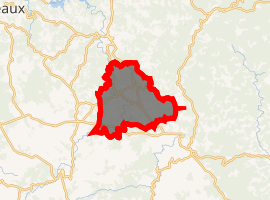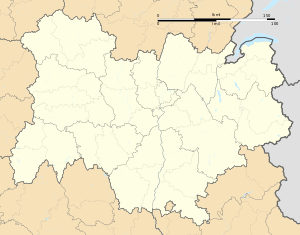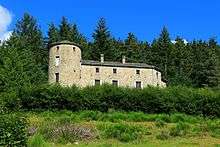Le Chambon-sur-Lignon
Le Chambon-sur-Lignon (French pronunciation: [lə ʃɑ̃bɔ̃ syʁ liɲɔ̃]; Auvergnat: Lo Chambon) is a commune in the Haute-Loire department in south-central France.
Le Chambon-sur-Lignon | |
|---|---|
Commune | |
Town hall | |
.svg.png) Coat of arms | |
Location of Le Chambon-sur-Lignon 
| |
 Le Chambon-sur-Lignon  Le Chambon-sur-Lignon | |
| Coordinates: 45°03′42″N 4°18′11″E | |
| Country | France |
| Region | Auvergne-Rhône-Alpes |
| Department | Haute-Loire |
| Arrondissement | Yssingeaux |
| Canton | Mézenc |
| Government | |
| • Mayor (2014–2020) | Eliane Wauquiez-Motte |
| Area 1 | 41.71 km2 (16.10 sq mi) |
| Population (2017-01-01)[1] | 2,470 |
| • Density | 59/km2 (150/sq mi) |
| Time zone | UTC+01:00 (CET) |
| • Summer (DST) | UTC+02:00 (CEST) |
| INSEE/Postal code | 43051 /43400 |
| Elevation | 874–1,139 m (2,867–3,737 ft) (avg. 1,000 m or 3,300 ft) |
| 1 French Land Register data, which excludes lakes, ponds, glaciers > 1 km2 (0.386 sq mi or 247 acres) and river estuaries. | |
Residents have been primarily Huguenot or Protestant since the 17th century. During World War II these Huguenot residents made the commune a haven for Jews fleeing from the Nazis. They hid them both within the town and countryside, and helped them flee to neutral Switzerland. In 1990 the town was one of two collectively honored as the Righteous Among the Nations by Yad Vashem in Israel for saving Jews in Nazi-occupied Europe. The other awardee was the Dutch village of Nieuwlande.
Geography
The town lies in the middle of the commune, on the right bank of the Lignon du Velay, which flows north-northwestward through the commune and forms part of its northwestern border.
World War II
During World War II, throughout France, the Nazis and the collaborationist Vichy regime were rounding up Jews and sending them to the death camps.
Under the remarkable leadership of local Protestant minister Pastor André Trocmé, and his deputy pastor Edouard Theis, the citizens of the village of Le Chambon-sur-Lignon risked their lives to rescue and hide Jews in private homes, on farms in the area, as well as in public institutions. Whenever the Nazi patrols came searching, the Jews were hidden in the mountainous countryside.
After the war, one of the villagers recalled: "As soon as the soldiers left, we would go into the forest and sing a song. When they heard that song, the Jews knew it was safe to come home." The situation took a more tense turn when the Germans invaded the South Zone in 1942. Local people continued to protect the Jews in open defiance of the authorities. For instance, they gave Vichy Youth Minister Georges Lamirand a petition against the deportation of the Jews when he visited the village in 1942.[2][3]
In addition to providing shelter, the citizens of the town obtained forged identification and ration cards for Jews to use. They helped them cross the border to the safety of neutral Switzerland. Some of the residents were arrested by the Gestapo such as Rev. Trocmé's cousin, Daniel Trocmé, who was sent to Maidanek concentration camp, where he was murdered.
It was estimated that the people of the area of Le Chambon-sur-Lignon had saved between 3,000-5,000 Jews from certain death.
Present day
The ethos and practice of sheltering refugees continues, with migrants coming from many war zones, including Congo, Libya, Rwanda, South Sudan, Kosovo and Chechnya.[4]
Population
| Year | Pop. | ±% |
|---|---|---|
| 1793 | 1,730 | — |
| 1806 | 1,976 | +14.2% |
| 1821 | 1,740 | −11.9% |
| 1831 | 2,400 | +37.9% |
| 1841 | 2,319 | −3.4% |
| 1851 | 2,329 | +0.4% |
| 1861 | 2,211 | −5.1% |
| 1872 | 2,155 | −2.5% |
| 1881 | 2,195 | +1.9% |
| 1891 | 2,327 | +6.0% |
| 1901 | 2,670 | +14.7% |
| 1911 | 2,642 | −1.0% |
| 1921 | 2,391 | −9.5% |
| 1931 | 2,543 | +6.4% |
| 1946 | 3,202 | +25.9% |
| 1954 | 3,183 | −0.6% |
| 1962 | 3,096 | −2.7% |
| 1975 | 2,811 | −9.2% |
| 1982 | 2,791 | −0.7% |
| 1990 | 2,854 | +2.3% |
| 1999 | 2,642 | −7.4% |
| 2008 | 2,662 | +0.8% |
| 2017 | 2,470 | −7.2% |
Honors
- In 1981 the entire town was awarded an honorary degree by Haverford College in Pennsylvania in recognition of its humanitarian efforts.
- In 1982, documentary filmmaker Pierre Sauvage—who was born and sheltered in Le Chambon—returned there to film Weapons of the Spirit[5] (1989).
- In 1990, for risking their lives to rescue Jews, the entire town was recognized as "Righteous Among the Nations". A small garden and plaque on the grounds of the Yad Vashem memorial to the Holocaust in Israel was dedicated to the people of Chambon-sur-Lignon.
- In 2004 French President Jacques Chirac officially recognized the heroism of the town.[6][7]
- In January 2007 they were honored along with the other French Righteous Among the Nations in a ceremony at the Panthéon in Paris.[6]
 The Pont-de-Mars Castle in Le Chambon-sur-Lignon
The Pont-de-Mars Castle in Le Chambon-sur-Lignon
Education
The town of Chambon-sur-Lignon is home to Le Collège-Lycée Cévenol International, a private boarding school founded in 1938 by local Protestant ministers André Trocmé and Edouard Theis.
Personalities
Alexander Grothendieck, a central figure of 20th century mathematics, was among the Jewish children sheltered during the war.
The paternal grandfather of actor Timothée Chalamet was from the town.[8]
Popular culture
Malcolm Gladwell uses Chambon-sur-Lignon in his book David and Goliath as an example of how the rebellious origin of its people influenced their actions when protecting Jewish people during the Second World War.[9]
Twin towns
- Fislisbach, Switzerland
- Meitar, Israel - since November 9, 2006
Notes
- "Populations légales 2017". INSEE. Retrieved 6 January 2020.
- Mordecai Paldiel, Churches and the Holocaust: Unholy Teaching, Good Samaritans, and Reconciliation, KTAV Publishing House, Inc., 2006, ISBN 9780881259087,443 pages, p.116
- See also: Gladwell, Malcolm. David and Goliath: Underdogs, Misfits, and the Art of Battling Giants. New York: Little, Brown and Company, 2013.
- Joshua Levine, "The Dispossessed," Smithsonian, & July-August 2018, p. 76.
- Weapons of the Spirit
- Jacques Chirac Honors French World War II Saviors, European Jewish Congress, 11 April 2007.
- Sauvage, Pierre (October 8, 2004). "Among the Villagers of Le Chambon". The Forward. Retrieved April 6, 2019.
- https://www.francebleu.fr/infos/medias-people/le-petit-fils-d-un-pasteur-du-chambon-sur-lignon-en-lice-pour-l-oscar-du-meilleur-acteur-1520005135
- Gladwell 2013, pp. 270-296.
References
- Gladwell, Malcolm (2013). David and Goliath : underdogs, misfits, and the art of battling giants. New York: Little, Brown and Company. ISBN 0-316-20436-6.CS1 maint: ref=harv (link)
- Grose, Peter (2015). A Good Place to Hide: How One French Community Saved Thousands Of Lives During World War II. New York: Pegasus Books LLC. ISBN 978-1-60598-692-0.
- Hallie, Philip P (1979). Lest Innocent Blood Be Shed: The Story of Le Chambon and How Goodness Happened There. New York: Harper & Row. ISBN 0-06-011701-X.
- Sauvage, Pierre (1989). Weapons of the Spirit (Les armes de l'esprit) (Documentary). USA/France: Chambon Foundation. Aired in the United States by the PBS.
- Matas, Carol (April 1, 1998). Greater Than Angels. New York: Simon & Schuster. ISBN 0-689-81353-8. A book for youngsters.
- Moorehead, Caroline (2014). Village of Secrets: Defying the Nazis in Vichy France. New York, NY: Harper, an imprint of HarperCollins Publishers. ISBN 978-0-06-220247-5.
- Sémelin, Jacques (2013). Persécutions et entraides dans la France occupée : comment 75 % des juifs de France ont échappé à la mort (in French). Paris: Seuil Arènes. ISBN 978-2-35204-235-8.CS1 maint: ref=harv (link)
External links
- Chambon Foundation
- About Le Chambon-sur-Lignon at Yad Vashem site
- Weapons of the Spirit on IMDb
- College-Lycee International Cevenol
- https://web.archive.org/web/20090507153307/http://www.ushmm.org/outreach/rescuchr.htm
- http://www.hiddenonthemountain.com/
| Wikimedia Commons has media related to Le Chambon-sur-Lignon. |